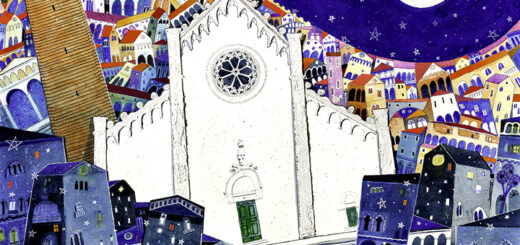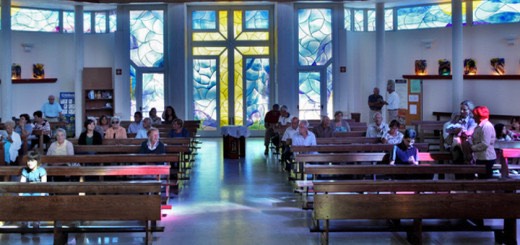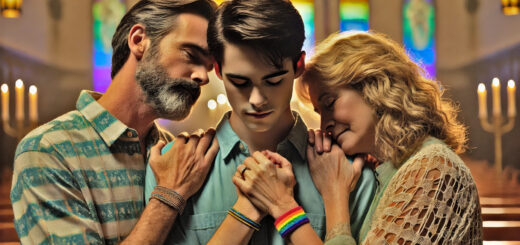Created as a prodigy. Being a transgender person in the Catholic Church
Text taken from the brochure made by LGBT+ Catholics Westminster, the LGBT+ Pastoral Service of the Catholic Diocese of Westminster (Great Britain), freely translated by Luigi and Valeria De Jonathan's tent
"Because you have created my being more intimate; You woven me in my mother's womb ». (Psalm 138, 13)
Frequent questions:
What does it mean to be a trans person or transgender?
A transgender person is a person whose gender identity is different from that typically associated with the sex that has been assigned to her at birth based on the genital organs, for example a transgender man is a person assigned female at birth, but who identifies himself as Man, while a transgender woman is a person assigned male at birth, but who identifies herself as a woman. Some people can identify themselves as a middle ground between men and women, or like neither of them. The opposite of Transgender is Cisgender (from the Latin prefix cis- which means "on here").
What is the difference between sex, gender and sexual orientation?
Sex refers to the physical aspect of a person, in particular to the reproductive organs and secondary sexual characteristics such as breast or face hair. The genre is more complex and can understand the intimate perception of the person of himself as a man or woman, the way in which he presents himself to the world (such as clothes, makeup and behavior) and roles he carries out in society (such as the care of others or physical work). The sexual orientation describes by those who are attracted to a person and is independent of his gender identity. Just like cisgender people, transgender people can be homosexual, bisexual, heterosexual or any other orientation.
How do you know you are transgender?
Although numerous studies have highlighted neurological and biochemical differences between transgender and cisgender people, there is no medical test to understand if you are a transgender. Many transgender people report that they have experienced gender dysphoria from an early age, feeling the malaise generated by "something that was wrong" in the way their body appeared or in the roles or in the gender expressions that was expected of them , while others may not question their gender identity to puberty or even later in life. In both cases, reaching the awareness of being transgender is usually a slow process that involves a great work of personal analysis, inner research (and prayer in the case of people of faith) and often the experimentation of different roles and gender expressions .
What is the transition?
La transizione è il percorso articolato che una persona transgender intraprende per portare il proprio corpo, la propria espressione di genere e il proprio ruolo sociale in linea con la propria identità di genere. Per alcuni può trattarsi semplicemente di cambiare nome e usare pronomi diversi, mentre altri possono sentire il bisogno di interventi medici come terapie ormonali o interventi chirurgici. Nel Regno Unito, la transizione medica richiede molteplici incontri con medici specialisti per un periodo di mesi o addirittura anni, per ridurre al minimo qualsiasi rischio per il benessere mentale o fisico della persona transgender. Questo processo è particolarmente lento e graduale nel caso delle persone giovani che richiedono la transizione, in considerazione del fatto che sono ancora in fase di sviluppo.
Essere transgender è un’ideologia o una moda?
Identifying itself as a transgender is simply a way to describe one's personal experience of the relationship between the intimate and external perception of self. It is not an ideological position, nor does it claim to impose any vision of reality to other people or to the world in general. Being transgender is not even a choice; Although it is not known exactly what the causes that lead people are to be, science currently suggests that biological factors, including genetics and the environment in the womb, can play an important role in determining the intimate perception of one's own kind of a person. Transgender people are present in countries and cultures around the world and there are many examples in the history of people who have identified themselves in a genre different from the sex assigned to birth and have expressed it throughout their lives. Transgender identity is therefore neither a new phenomenon nor confined to western culture.
What does the Church say?
To date, the Roman Catholic Church has not published any official teaching on transgender people. However, some leaders of the Church, including Pope Francis and the Catholic Episcopal Conference of England and Wales, have recognized the discomfort that transgender people feel because of gender dysphoria and urged the church to welcome them with respect and compassion. Pope Francis himself met a transgender man and his wife, and told journalists: «In any case, welcome, accompany, deepen, discern and integrate. This is what Jesus would do today ». In a declaration on transsexuals, the episcopal conference said: «We [...] want to accompany them with benevolence, underlining that they are loved by God and have value for their intrinsic divine dignity. There is welcome for everyone in the Catholic Church ».
How can I help transgender people to feel welcome to the church?
- The most important thing to remember is that transgender people are human beings, with the same emotional and spiritual needs as anyone else. Try to meet them and know them as people and brothers and sisters in Christ, rather than seeing them as pawns or stereotypes.
- If you are not sure on which pronoun to use with someone, ask him kindly and endeavor to use it, especially when you talk to others. In this you can follow the example of Pope Francis, who used the male pronouns to refer to the trans man he met: "He who was a she, but is a he", and female pronouns when he referred to trans women in Argentina.
- Do not judge people based on their external appearance, and do not make assumptions about their sexual identity, sexual orientation or medical interventions. Do not ask intrusive questions, especially on the body or the relationships of a person.
- Try to know and deepen the difficulties and experiences of transgender people and share with others what you learned. Some in -depth tools are listed on the back of this flyer.
- Pray for the Transgender Community and for the Church, so that we can find together a path that leads us to the encounter.
Catholic transgender items
"I was terrified on the first Sunday in which I participated in the mass as evidently transgender; I was overwhelmed by the reception that was reserved for me when I did it“. (Jane)
"When I made it after making the decision of the transition, it was the first time in my life that I felt I had a real conversation with God. It was as if for all my life I had recited the part of the person with whom I thought God wanted to speak , and I finally took off my mask“. (Ben)
"You have nothing to apologize for; You do not choose to be more translate than you choose to be born black or white or brown or any other skin color. Think about the message that Jesus brought with him: He and the Father offer us unconditional love ". (Lorena)
To know more. Support groups and websites in English:
- LGBT+ Catholics Westminster - an LGBT+ pastoral service of the diocese of Westminster.
- Quest - Pastoral support for LGBT+Catholics.
- The Sibyls - Reserved group of Christian spirituality for transgender people.
- TransCatholic - a new international organization to support the dignity and inclusion of the transgender lay people.
- Transfaith - Archive of multireligious documents for transgender people and groups of faith.
- Mermaids - Support for children with gender variance and for their families.
- Depend - Support for the spouses and partners of transgender people.
- Ride (Gender Identity Research & Education Service)-Provides advice to trans and gender non-conforming, as well as education and training for organizations.
Books:
- This is my body: Hearing Theology of Transgender Christians (This is my body: listening to the theology of transgender Christians),by Christina Beardsley and Michelle O'Brien (Eds.) (2016)
- Walking Toward Resurrection: A Transgender Passion (Walking towards the resurrection: a transgender narration of passion) of Shannon TL Kearns (2015)
Original text: Wonderfully Created. An introduction to Being Transgender and the Catholic Church (PDF file)






